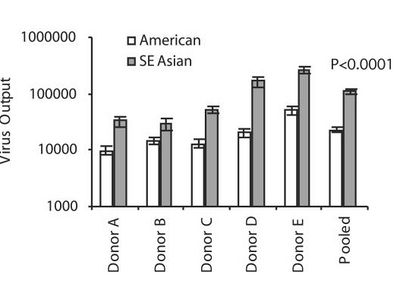Effects of Pathogen-Vector Interactions on the Transmission of Dengue Virus
Types of DENV strains
There are multiple ways to classifications DENV srains depending on the context.Dengue viruses maintaining transmission mostly between nonhuman primates and forest dwelling Aedes aegypti are considered sylvatic. It was once thought that sylvatic strains were less virulent than epidemic or endemic strains of DENV. Some believed sylvatic strains lacked the potential to cause virulent epidemics because cases of sylvatic dengue fever are rare when compared to overall incidence of of dengue fever. As it turns out, sylvatic strains share the same pathogenic potential as strains found in urban areas. There are reported cases dengue hemorrhagic fever from infection with sylvatic DENV. The destruction of forest areas where sylvatic strains of DENV are maintained has not even lead to a decrease in outbreaks of sylvatic DENV in West Africa [18].
Epidemic and endemic DENV strains infect and replicate within humans and domesticated Aedes species [9].
The distinction between epidemic and endemic dengue has become hazy as epidemic strains of DENV have become endemic in tropical urban slums. In areas where there is poor sanitation, free standing water, high population density, and constant human traffic allow continuous transmission of the virus (Figure 1)[4,8]. Epidemic strains of DENV are best transmitted by Aedes ageypti mosquitoes but can be transmitted less efficiently by other Aedes species and cause[19]. Epidemic strains can also produce large fast moving epidemics if a number of factors create high density vectors populations in close proximity to high density host populations [20].
?????????Innvassive species are defined as newer genotypes and strains not previously seen in a particular area or geographic region. They tend to cause large epidemics because the population in that area does not have homologous immunity to the virus. Noninvasive species are strains that have been present for some time and continue to be tranmissted to new susceptible hosts in the area. They can be thought of more as endemic strains. Invassive species can be more virulent than noninvassice strains but this is dependent on host population susceptibility which depends on what other strains of DENV are circulating at the time. Superinfection of the same vector can decrease overall titers of both infecting strains (asymmetric competitive suppression) and if the innvassive strain is less competitive/virulent than existing dengue strains in may not be able to colonize that geographic area (asymmetric as well as selection for dengue).
400px|thumb|center|Figure ?. Simplified epidemiological triad for dengue virus transmission. Note the number of factors that influence DENV replication in mosquito vector.
Two of the most common types of genotypes mentioned in the literature are America and Southeast Asian. They are commonly compared because of known differences in virulence genotype which allows researchers to look for differences in replication, infectivty and other factors that may explain why certain strains of DENV are worse than others. American genotypes tend to be less virulent as well as less competitive than Southeast Asian strains (selection for dengue viruses in humans and mosquitoes). In both mosquitoe and human dendritic cells Southeast Asian genotypes have higher rates of replication than American genotypes resulting in higher viral titers in humans….uhhhh

Southeast Asian genotypes also outcompete American genotypes when coninfecting mosquito hosts by replicating and disseminating to the salivary glands faster.
